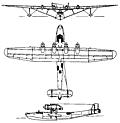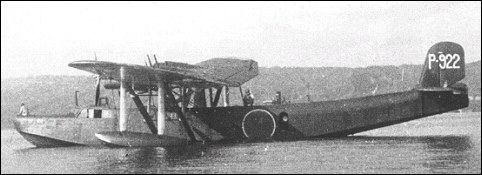|
| Owing much to current American and
French flying-boat design of the mid-
1930s, the large four-engine Kawanishi
Type 97 parasol monoplane flying boat,
which had first flown in July 1936,
was Japan's only in-service long-range
reconnaissance flying-boat when that
nation went to war in December 1941,
much effort having been dissipated in
transport conversions and deliveries
to Japan's commercial operators in the
Pacific. The H6K1 initial military version
entered limited service with the
Imperial Japanese Navy in 1938, and
was followed by 10 H6K2 flying-boats.
The first major production version, the
H6K4 was powered by four Mitsubishsi
Kinsei 43 radiais and armed with four
7.7mm machine-guns in
bow and midships positions and a 20mm cannon in a tail turret, and was
capable of carrying two 800kg bombs or torpedoes, a total of 66
being in service at the time of Pearl
Harbor; later aircraft were powered
by Kinsei 46 engines. These boats
were widely employed, although the
initial heavy defeats inflicted on the
Allies in the Pacific rendered maritime
reconnaissance duties subordinate to
the need for air transportation of
Japanese troops during the swift conquests
in the East Indies and elsewhere.
A number of aircraft, designated
H6K4-L, were therefore converted
for transport duties and were
each able to accommodate about 18
fully-armed troops; lacking armour
and self-sealing fuel tanks, however,
they were extremely vulnerable to
fighter attacks and, after a number had
been shot down, a new version entered
production as the H6K5 in August
1942; by that time the maritime reconnaissance
version had been given the
reporting codename 'Mavis' by the
Allies, the transport derivative being
named 'Tillie'. Powered by either Kinsei
51 or 53 radials, the H6K5 was intended
to eliminate the shortcomings
of the earlier versions, but although the
open bow gun position was replaced
by a single-gun turret immediately aft
of the pilot's cockpit, the overall armament
was not increased. Only 36
H6K5s were completed by 1943, when
production gave place to the greatly
superior H8K. H6Ks served with the
8th, 14th, 801st, Toko and Yokohama
Kokutais, and some of the H6K5s were
employed as naval staff transports
throughout the Pacific in 1943. Eighteen
aircraft served on the quasicommercial
courier services in South
East Asia, a number of them being destroyed
by Allied aircraft both in the air
and at their moorings.

| MODEL | H6K5 |
| CREW | 10 |
| ENGINE | 4 x Mitsubishi "Kinsei-51", 975kW |
| WEIGHTS |
| Take-off weight | 17500-23000 kg | 38581 - 50707 lb |
| Empty weight | 12380 kg | 27293 lb |
| DIMENSIONS |
| Wingspan | 40 m | 131 ft 3 in |
| Length | 25.63 m | 84 ft 1 in |
| Height | 6.27 m | 21 ft 7 in |
| Wing area | 170 m2 | 1829.86 sq ft |
| PERFORMANCE |
| Max. speed | 380 km/h | 236 mph |
| Cruise speed | 255 km/h | 158 mph |
| Ceiling | 9560 m | 31350 ft |
| Range | 4870 km | 3026 miles |
| Range w/max.fuel | 6670 km | 4145 miles |
| ARMAMENT | 1 x 20mm cannon, 4 x 7.7mm machine-guns, 2 x 800-kg torpedos or 1000kg of bombs |
 | A three-view drawing (752 x 772) |
| orian, e-mail, 22.06.2011 00:40 i would like to find the plans to build a model, is this posible? reply |
| huaren, 20.06.2011 07:00 Kamimiya (sic) said that the Wirraway did inflict damage on an engine and cockpit area and killed some crew. reply | | Patrick Farnell, e-mail, 01.09.2010 01:51 In "Miracle at Midway", several references are made to Midways patrol search PBYs running into "Mitsubishi Patrol bombers" from Wake Island and suffering damage, elsewhere these are referred to "Type 96 Mitsubishis"...obviously faulty identifications of Japanese types were frequent in those days, it does not say if the Japanese aircraft were flying boats or landplanes, but Wiki article on PBY seems to suggest that they were Mavis FBs being referred to...there is very little info on large Japanese aircraft based on Wake Is on the net...does anyone know for sure what kind of planes these were harassing the Midway Catalinas? reply | | Mick Dunne, e-mail, 29.12.2007 05:05 Might have been Lt. R. Kamamiya. Will check. I have a complete list of IJN Pilots and Squadrons (somewhere) reply |
|
| | Lex McAulay, e-mail, 18.09.2007 07:54 In January 1942 a Mavis was attacked in a single head-on pass off Kavieng, New Ireland by an Australian Wirraway.
post-war, the Australian pilot, John M. Lerew, at an aviation conference in Tokyo, met a Japanese who said he was the Emily pilot. Lerew thought his name was Kamimiya but no one with that name has so far been linked to the Mavis units.
Kamimiya (sic) said that the Wirraway did inflict damage on an engine and cockpit area and killed some crew.
Any info on this will be welcome.
Lex reply |
|
Do you have any comments?
|
| 
COMPANY
PROFILE
All the World's Rotorcraft
|








 Mick Dunne
Mick Dunne
Hasegawa makes a good one.
reply